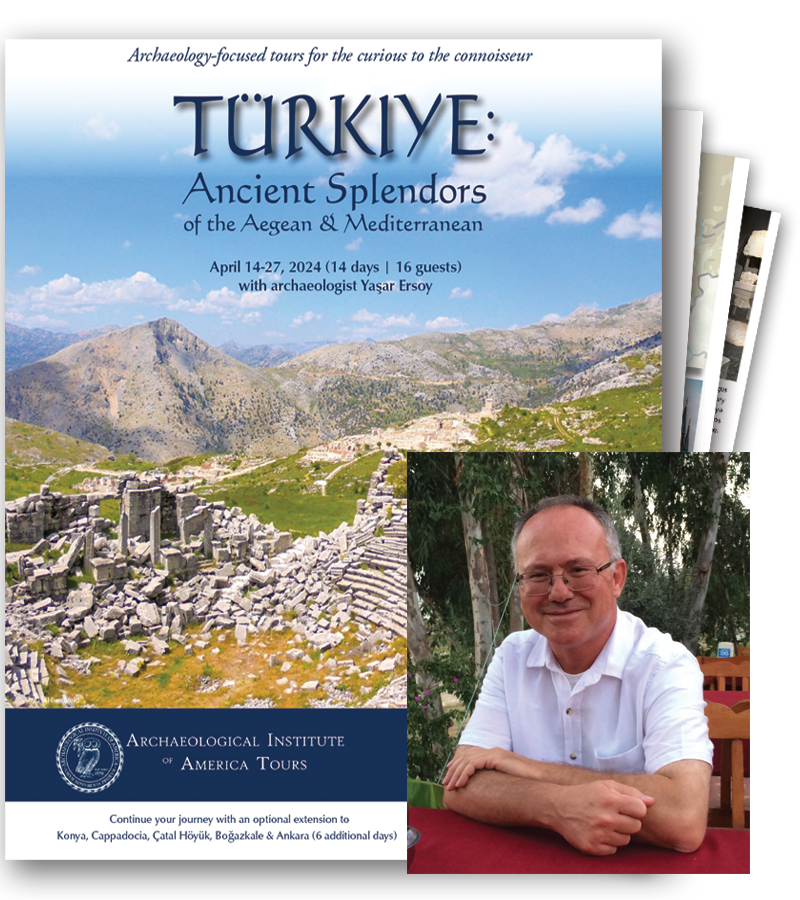For reservations or questions, please email us at aia@studytours.org (and include your full name) or call us toll-free at (800) 748-6262 (toll: 603-756-2884).
Many of the most magnificent and best-preserved ancient Greek and Roman sites are found along Türkiye’s beautiful Aegean and Mediterranean coasts. Visit world-famous, plus little-visited yet spectacular, Greco-Roman sites, Byzantine churches, Crusader castles, and Ottoman palaces. Your engaging AIA lecturer/host, Yaşar Ersoy, teaches classical art and archaeology and has been doing fieldwork in Türkiye since 1980. Throughout the program he will offer illustrated talks and informal discussions about the sites you are visiting and their places within the larger ancient Mediterranean world. Along the way, you will enjoy delicious cuisine, comfortable accommodations, and the company of a small group of like-minded fellow travelers. An expert tour manager/local guide will handle logistics and smooth the way.
Highlights:
- Visit three UNESCO World Heritage Sites:
- Historic Areas of Istanbul, including the 6th-century Byzantine church-turned-mosque of Hagia Sophia; Topkapi Palace, the imperial residence of the Ottoman sultans; and the 17th-century Blue Mosque, with thousands of dazzling Iznik tiles;
- Ephesus, the best-preserved classical city in the eastern Mediterranean, whose treasures include ancient villas with splendid frescoes and mosaics, and the 2nd-century A.D. Library of Celsus;
- Aphrodisias, whose Temple of Aphrodite, tetrapylon, and baths of Hadrian are unforgettable.
- Marvel at a variety of Greco-Roman sites, including:
- Didyma’s 7th-century B.C. Temple of Apollo, one of the leading oracles in the ancient world; and the 4th-century B.C. Temple of Athena at Priene, which became the classical model of Greek city planning;
- Kibyra, with its magnificent stadium, odeon covered with a Medusa mosaic, late Roman bath, and underground tombs;
- Sagalassos, a rarely visited and recently excavated site at an elevation of 5,000 feet, with breathtaking views;
- Aspendos, with one of the best-preserved ancient theaters in the world, renowned for its acoustics; and Perge, with its splendid theater, stadium, and enormous Hellenistic and Roman gates.
- Explore spectacular museum collections, including Istanbul’s Archaeological Museum and Museum of Turkish and Islamic Art; Bodrum’s Underwater Archaeology Museum; and the Antalya Archaeological Museum.
- Two flights within Türkiye are included to maximize your time.
- An optional extension to central Türkiye is also available, including three UNESCO World Heritage Sites: Göreme National Park and the Rock Sites of Cappadocia, Hattusha: the Hittite Capital, and the Neolithic Site of Çatalhöyük; Ankara, with its superb Museum of Anatolian Civilizations; and Konya, the famous center of Sufi mystic Rumi and his followers.
Tour Pricing (Per Person, double occupancy) 12 nights
13-16 participants $5,945
10-12 participants $6,345
Single supplement (limited availability) $955
Optional Post-tour Extension (5 additional nights)
14-16 participants $2,845
10-13 participants $3,145
5-9 participants $3,445
Single supplement (limited availability) $595
Download the detailed brochure for complete pricing and information.
To reserve your space using the online form, click here.
For reservations or questions, please email us at aia@studytours.org (and include your full name) or call us toll-free at (800) 748-6262 (toll: 603-756-2884).
